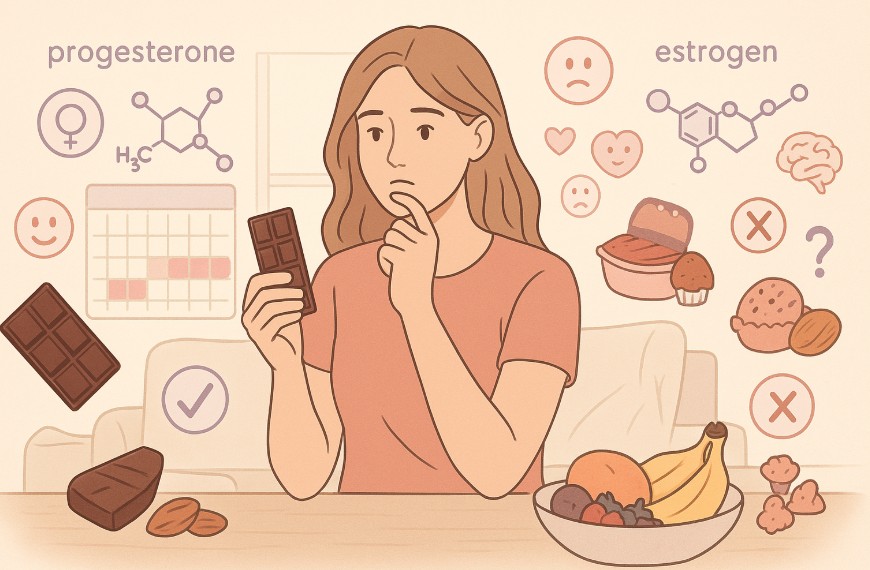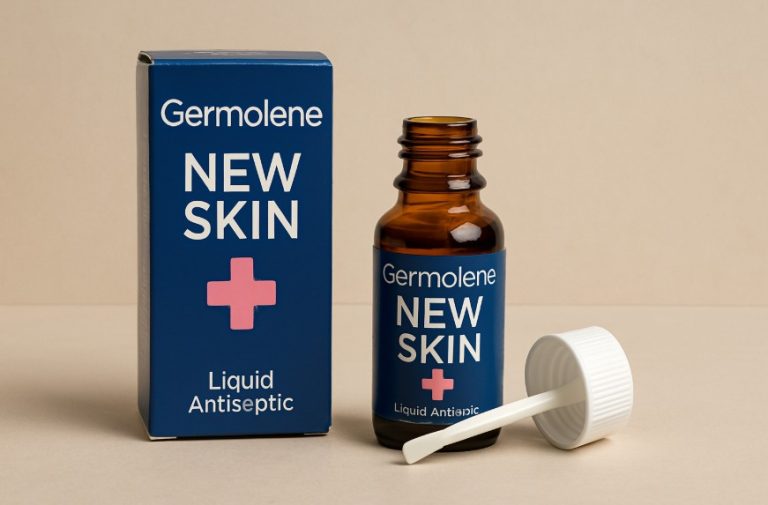Why Do I Crave Chocolate On My Period? | The Surprising Science Behind It
Experiencing a sudden, almost irresistible craving for chocolate right before or during my period is something I’ve often wondered about. It turns out, there’s real science behind this monthly urge.
From hormonal fluctuations to nutrient deficiencies and emotional changes, several factors are at play. In this post, I’ll walk through the surprising science behind why I crave chocolate on my period, and what it could mean for my body.
What Causes Intense Chocolate Cravings During My Period?
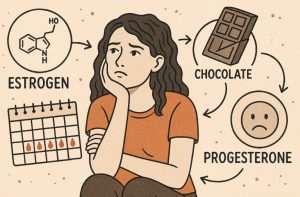
Every month, as my period approaches, I notice the same pattern will overwhelming craving for chocolate. While it might feel like a guilty indulgence, this craving is actually rooted in complex biological, emotional, and nutritional factors.
One of the primary causes is the fluctuation in hormone levels during the luteal phase of the menstrual cycle the days between ovulation and the start of menstruation.
During this phase, oestrogen and progesterone levels decline, which affects brain chemistry, particularly the neurotransmitter serotonin. Serotonin is known for regulating mood, appetite, and sleep.
As its levels drop, I may begin to feel irritable, anxious, or down, and my body looks for ways to boost it. Chocolate contains compounds that stimulate serotonin production, making it a naturally appealing choice.
Additionally, my body’s energy needs increase slightly before menstruation. This increase, combined with shifting blood sugar levels and heightened sensitivity to insulin, can lead to stronger cravings for sugar and carbohydrates, both of which are found in chocolate.
Chocolate also offers a sense of emotional comfort. Its smooth texture, rich taste, and instant satisfaction activate the brain’s reward system, particularly the release of dopamine, creating a temporary mood lift. That feel-good sensation is why many of us instinctively reach for it during stressful or uncomfortable times.
Reasons Behind Period Chocolate Cravings
| Cause | Explanation | Related Body Function |
| Hormonal Fluctuations | Drop in oestrogen and progesterone affects serotonin levels | Mood regulation and appetite |
| Serotonin Deficiency | Lower serotonin levels cause low mood, chocolate helps boost it | Neurotransmitter imbalance |
| Increased Energy Needs | Body needs more calories premenstrually, especially carbs and sugar | Metabolism and blood sugar |
| Emotional Stress | Chocolate provides comfort and activates dopamine | Brain’s reward response |
| Cultural and Habitual Factors | Social cues and past experiences associate chocolate with relief and care | Learned behaviour and rituals |
Is There a Scientific Link Between Chocolate and Hormones?

Yes, and it’s quite compelling. Hormones like oestrogen and progesterone don’t just affect reproductive health they influence how I feel, think, and even what I want to eat.
As these hormones fluctuate throughout my menstrual cycle, my brain chemistry responds, often resulting in mood changes and shifts in food preference.
Chocolate impacts several key neurotransmitters. It increases serotonin, which stabilises mood and reduces anxiety.
It also stimulates dopamine, the brain’s reward chemical, giving me a sense of pleasure and satisfaction when I eat it. This neurological response can make chocolate feel almost irresistible, especially during emotionally vulnerable times like PMS.
Furthermore, chocolate contains small amounts of theobromine and caffeine, mild stimulants that can improve alertness and fight fatigue symptoms that are common during menstruation.
This combination of mood elevation and energy boost makes chocolate a particularly attractive option when my hormone levels are at their lowest.
Is Chocolate Good for Your Period?

Yes, dark chocolate can be especially beneficial during your period when consumed in moderation and with the right nutritional profile.
Here’s why it can help:
1. Rich in Magnesium
Dark chocolate contains magnesium, which may help ease menstrual cramps, reduce irritability, and regulate mood. Magnesium supports muscle relaxation and helps balance mood-related hormones like serotonin.
2. Boosts Mood
Chocolate stimulates the release of serotonin and endorphins, which can lift your mood and combat PMS-related irritability or sadness.
3. Iron Content
During menstruation, iron levels may drop due to blood loss. Dark chocolate contains iron, which can support energy levels and reduce fatigue.
4. Anti-inflammatory Properties
Dark chocolate has antioxidants (like flavonoids) that may reduce inflammation and help ease discomfort or bloating associated with menstruation.
But be cautious with:
- Milk chocolate or highly processed chocolates, which are high in sugar, unhealthy fats, and additives that may worsen bloating or cause energy crashes.
- Overconsumption, which could lead to increased cravings, acne, or digestive discomfort.
Best Practice:
Go for 70% dark chocolate or higher, and limit yourself to a few squares a day. Pair it with other nutrient-rich foods like nuts or fruit to stay balanced.
Let me know if you’d like this added as a section in your blog or turned into an infographic-style visual!
Could Magnesium Deficiency Be Making Me Crave Chocolate?

Magnesium is a mineral that plays a vital role in muscle function, nervous system regulation, and energy production, all areas that are particularly stressed during menstruation.
It turns out that magnesium levels tend to drop during the premenstrual phase, which may trigger my body to seek out magnesium-rich foods without me consciously realising it.
Chocolate, particularly dark chocolate, is a notable source of magnesium. So, when I find myself reaching for a bar of chocolate, it might be my body’s way of correcting a deficiency. This craving can be viewed as a subtle survival mechanism my body is looking out for itself.
What’s more, magnesium is involved in regulating mood and calming the nervous system, which can help alleviate symptoms of PMS like irritability, anxiety, and mood swings.
So, the craving for chocolate may not just be about taste or comfort, but a genuine need for a nutrient that supports hormonal and neurological balance.
Other magnesium-rich foods that I try to include in my diet are leafy greens like spinach and kale, legumes such as lentils and chickpeas, nuts like almonds and cashews, and seeds like pumpkin or chia. Including these in my meals can help reduce the intensity of chocolate cravings and support my overall cycle health.
Do Emotional Changes Play a Role in Period Cravings?
The emotional aspect of period cravings is just as powerful as the physical and biochemical ones.
During the days leading up to my period, I often notice a heightened sensitivity to stress, lower frustration tolerance, and stronger emotional reactions. These changes are largely driven by the drop in oestrogen and serotonin levels.
When I feel overwhelmed, tired, or down, I’m more likely to seek out comfort through food. Chocolate offers a fast-acting form of comfort, both in its taste and in the way it triggers dopamine release in the brain. This emotional association reinforces my cravings, creating a cycle that becomes habitual over time.
Moreover, I’ve noticed that the texture and sweetness of chocolate play a role in its comforting effect.
The creamy consistency, the melt-in-the-mouth sensation, and the sweet flavour profile make chocolate particularly soothing during emotional distress. This sensory experience helps me feel more grounded and supported, even if just temporarily.
Interestingly, the emotional connection to chocolate is also influenced by social and cultural factors. In many parts of the world, chocolate is marketed and consumed as a “feel-good” treat, often linked to self-care and indulgence particularly for women.
This narrative reinforces the idea that it’s normal or even expected for me to crave chocolate during my period, further strengthening the behaviour.
Is It Okay to Eat Chocolate on My Period?
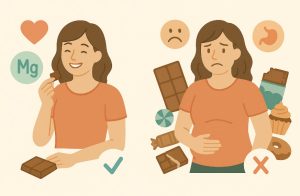
The short answer is yes enjoying chocolate during my period can be perfectly fine, especially if I choose wisely and remain mindful of how much I’m eating. In fact, dark chocolate has several health benefits that align with the needs of my body during menstruation.
Dark chocolate (with at least 70% cocoa content) is rich in iron, magnesium, antioxidants, and flavonoids all of which support better circulation, reduce inflammation, and help stabilise mood. Eating a small amount of high-quality dark chocolate can actually be beneficial during this time.
On the other hand, overly processed milk chocolate is high in refined sugars, unhealthy fats, and artificial additives.
While it may offer a temporary boost in energy or mood, it can also lead to sugar crashes, increased bloating, and acne flare-ups, which I’d rather avoid during my cycle.
That’s why I aim for moderation. I allow myself to indulge but set boundaries. Having a square or two of dark chocolate after a meal can satisfy my cravings without overwhelming my system or derailing my nutritional goals.
Are There Healthy Alternatives to Chocolate During My Period?
If I want to reduce my sugar intake or simply explore other options, there are several healthy alternatives that satisfy similar cravings without the side effects.
These foods mimic the brain-boosting or magnesium-rich properties of chocolate and can support hormonal balance:
- Greek yoghurt with raw cacao or berries: provides probiotics, protein, and antioxidants.
- Bananas and almonds: bananas increase serotonin naturally, and almonds are magnesium-rich.
- Chia pudding with unsweetened cocoa powder: combines fibre, omega-3s, and chocolate flavour.
- Roasted pumpkin seeds: high in zinc and magnesium, and satisfy the crunch craving.
- Smoothies made with spinach, cacao, and nut butter: a complete hormonal support drink.
Making these alternatives a part of my routine doesn’t mean I give up chocolate entirely. Instead, I balance my intake and offer my body the nutrients it truly needs during this time of the month.
Can I Reduce My Chocolate Cravings Through Diet or Lifestyle?
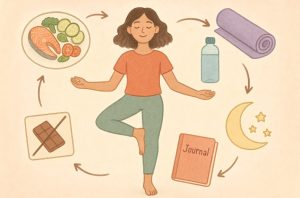
Absolutely my experience has shown that when I take better care of my body through diet and lifestyle, my cravings become less intense and more manageable. There’s no quick fix, but a few foundational habits can make a significant difference.
Eating balanced meals that include complex carbohydrates, protein, and healthy fats helps stabilise blood sugar levels, reducing those sudden spikes and crashes that often lead me to crave sugar or chocolate. Skipping meals or eating too much refined food can make cravings worse.
Hydration also plays a crucial role. I’ve noticed that dehydration can amplify fatigue and irritability, both of which drive emotional eating. Drinking water consistently throughout the day helps flush out toxins and keeps my energy levels steady.
Movement is another powerful tool. Even light exercise like walking, stretching, or yoga can release endorphins and boost serotonin, improving my mood naturally.
When I stay active in the days leading up to my period, I often feel less reliant on chocolate for emotional relief.
Sleep is the final piece of the puzzle. Lack of quality rest increases cortisol (the stress hormone), which can make me crave high-sugar foods.
By prioritising sleep hygiene like winding down before bed, limiting caffeine late in the day, and sticking to a consistent bedtime, I support my hormonal balance more effectively.
Is Chocolate Craving the Same for Everyone?
No, it’s not. While craving chocolate around menstruation is a common experience, the frequency, intensity, and type of craving can vary greatly from person to person. Some women may crave salty foods, others may prefer carbs, and some might not experience strong cravings at all.
There are several factors influencing this. Genetics, for instance, play a role in how our bodies respond to hormonal shifts and how we metabolise certain nutrients.
Some of us may be more sensitive to changes in serotonin or blood sugar, which makes cravings more pronounced.
Cultural context is another big influence. In countries where chocolate isn’t commonly associated with femininity or self-care, studies have shown women report fewer chocolate cravings during their cycle. This suggests that part of my craving might be learned or reinforced by cultural messaging.
Emotional health and stress levels also affect food cravings. If I’m under a lot of pressure at work or in my personal life, my cravings during PMS tend to be more intense and harder to resist. On the flip side, when I feel supported and well-rested, I notice that I have more control over my dietary choices.
What Are Some Common Myths About Chocolate and Periods?
There’s no shortage of myths surrounding chocolate and menstruation, many of which I’ve encountered over the years.
One of the most persistent is the idea that craving chocolate is a sign of weakness or emotional instability. In reality, it’s a natural response to hormonal and biochemical shifts.
Another myth is that eating chocolate makes PMS symptoms worse. While processed, sugary chocolate might contribute to bloating or acne, moderate consumption of dark chocolate can actually help reduce cramps, stabilise mood, and provide beneficial nutrients.
There’s also the belief that craving chocolate means I’m addicted. While chocolate does activate the brain’s reward system, it doesn’t meet the clinical criteria for addiction. The cravings are more about temporary mood regulation than dependency.
Finally, some people assume that chocolate cravings are universal among women, but that’s not true.
As mentioned earlier, individual responses vary due to biology, culture, and lifestyle. Understanding the science behind my cravings helps me approach them with curiosity rather than guilt or confusion.
What Are the Other Ways to Satisfy My Period Craving?
While chocolate may be the classic go-to during my period, I’ve discovered that there are plenty of other satisfying options that help curb cravings, support my body’s needs, and keep my mood steady.
These alternatives not only satisfy my sweet tooth or desire for comfort food but also provide valuable nutrients that assist in easing PMS symptoms and hormonal fluctuations.
1. Fruits with Natural Sugars

Cravings are often a sign that my body needs energy, particularly glucose. Fresh fruits offer natural sugars along with fibre, antioxidants, and hydration, all of which help balance blood sugar and reduce mood swings.
Some of my favourites include:
- Bananas (rich in potassium and vitamin B6 for mood support)
- Berries (high in antioxidants and fibre)
- Mango or pineapple (satisfy sweet cravings and aid digestion)
- Apples with almond butter (a balanced snack with healthy fats and fibre)
2. Magnesium-Rich Snacks
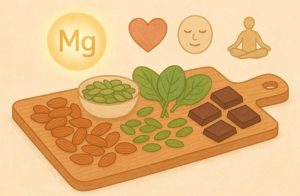
Since magnesium levels often drop during menstruation, snacking on magnesium-rich foods can reduce chocolate cravings and support muscle relaxation, which may relieve cramps.
Good magnesium-rich snacks include:
- Almonds, cashews, and walnuts
- Pumpkin or sunflower seeds
- Dark leafy greens (like kale chips or spinach smoothies)
- Avocados on wholegrain toast
3. Warm Herbal Drinks

When I’m craving something comforting, warm beverages are incredibly soothing. Herbal teas not only help me relax but also target specific symptoms like bloating, irritability, or fatigue.
Some helpful choices are:
- Peppermint tea (eases bloating and cramps)
- Chamomile tea (calms nerves and supports sleep)
- Ginger tea (helps with digestion and inflammation)
- Cinnamon tea (stabilises blood sugar levels)
4. Healthy Baked Goods
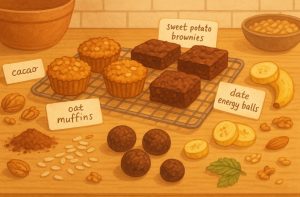
Sometimes I just want a treat and that’s perfectly okay. Instead of shop-bought desserts loaded with refined sugar and additives, I opt for homemade or naturally sweetened treats.
Some satisfying, period-friendly bakes I enjoy:
- Oat and banana muffins (with dark chocolate chips)
- Sweet potato brownies (a magnesium- and fibre-rich option)
- Energy balls made with dates, oats, and cacao
- Baked apples with cinnamon and nut butter
5. Complex Carbohydrates
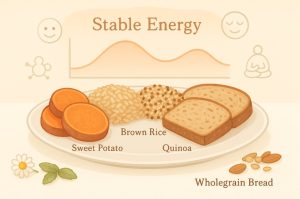
Simple carbs (like white bread or pastries) cause blood sugar spikes followed by crashes, which worsen cravings. I’ve found that complex carbs keep me full longer and help with energy and mood regulation.
Some options I rely on:
- Brown rice, quinoa, or wholegrain pasta
- Sweet potatoes or roasted root vegetables
- Wholegrain crackers with hummus
- Porridge with chia seeds, fruit, and a drizzle of honey
6. Protein and Healthy Fats

Combining protein and healthy fats in my snacks helps regulate hunger hormones and stabilise energy. They also help me feel more satisfied, so I’m less likely to overeat sugary foods.
Smart snack ideas:
- Greek yoghurt with flaxseeds and fruit
- Boiled eggs with avocado slices
- A small handful of trail mix (without added sugar)
- Nut butter on rye toast
Final Thoughts
Craving chocolate on my period isn’t just a quirky monthly habit, it’s a real physiological and emotional response to what my body is going through.
By understanding the underlying reasons, I can respond more mindfully and support my body’s needs, whether that means indulging in dark chocolate or choosing a healthier alternative.
The more I learn about my body, the better I can care for it cravings and all.
FAQs
Why do I crave sweets before my period starts?
This is often due to hormonal changes, particularly the drop in serotonin, which can trigger cravings for carbohydrates and sugary foods that temporarily elevate mood.
Is craving chocolate a sign of low magnesium?
Yes, it could be. Chocolate is high in magnesium, and your body may crave it when magnesium levels are low, especially during menstruation.
Can hormonal birth control affect my cravings?
Hormonal contraceptives can alter the levels of oestrogen and progesterone, potentially reducing or increasing cravings depending on how your body responds.
How much chocolate is safe to eat during my period?
Moderation is key. A few squares of dark chocolate per day can be beneficial without overloading your system with sugar or fat.
Why does chocolate help my mood during PMS?
Chocolate boosts serotonin and dopamine levels, which improves mood and offers temporary relief from symptoms of PMS such as irritability and fatigue.
Are there any supplements that reduce period cravings?
Magnesium, vitamin B6, and omega-3 supplements have been shown to help with PMS symptoms, including food cravings. Always consult a healthcare provider first.
Should I cut sugar out completely during my cycle?
Cutting sugar entirely isn’t necessary, but reducing processed sugar and opting for natural alternatives can help stabilise mood and energy levels.

